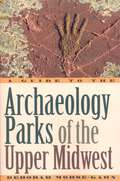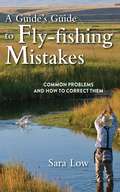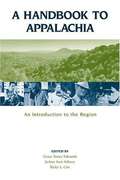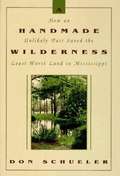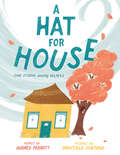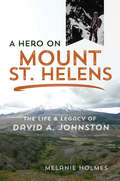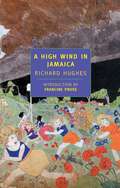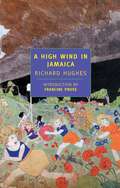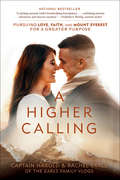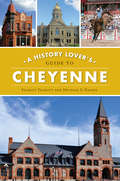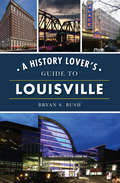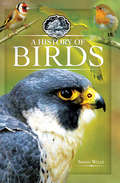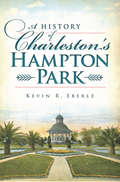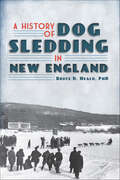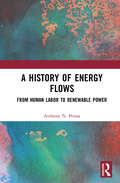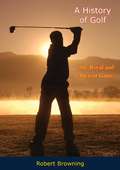- Table View
- List View
A Guide to the Archaeology Parks of the Upper Midwest
by Deborah Morse-KahnThe archaeology enthusiast will find this versatile guide contains treasure trove of information. A generous collection of black and white photos are scattered throughout this handy book, along with detailed maps, lodging and dining suggestions, and a broad listing of additional local points of interest. The volume's brief introductory chapters offer an overview of the archaeology of the Upper Midwest and explore the symbols and meanings of intricate rock art and effigy mounds.Eighty-five dedicated archaeology parks exist in Minnesota, Wisconsin, Iowa, and northern Illinois. Wisconsin alone contains sixty-three of these outstanding parks. From Effigy National Monument in Iowa to the privately held Henschel Mounds in Wisconsin, this magnitude of managed sites is exceeded only by the abundance of archaeology sites found in the American Southwest.
A Guide's Guide to Fly-Fishing Mistakes: Common Problems and How to Correct Them
by Rod Walinchus Sara LowA licensed fishing guide’s observations on the common mistakes made by anglers, A Guide’s Guide to Fly-Fishing Mistakes provides practical tips on how to improve fly-fishing techniques and break bad habits. Licensed fishing guide and instructor Sara Low offers remedies to freshwater anglers on topics that include correctly approaching fish, improving fly selection, proper presentation, consistent and accurate casting, efficient hooking and landing of fish, as well as pointers for fishing spring, summer, fall, and winter.Although written for anglers with experience, the notes will be just as helpful to anglers who have not had time to develop bad habits. Low elaborates on how to fix the mistakes many experienced fly-fishers make. Supplementing her methods are tales that illustrate different mistakes made on the water with her suggested correction for each mistake. Taking these suggestions to heart will provide you with that “ah-ha!” moment you’ve been waiting for.As a guide, Low sees the same mistakes being made over and over again. Now you can see them too with this must-have resource. More fish, bigger fish, better fish—whatever the goal, the experienced and novice angler will find meaningful advice for greater fishing success.
A Handbook for Survivalists: Caring for the Earth, A Series of Meditations
by Llewellyn Vaughan-LeeWritten while under a wildfire evacuation warning, with bags packed, A Handbook for Survivalists explores the true nature of our survival at this pivotal moment in our shared journey together with the Earth. The present pandemic and its accompanying economic crisis, together with the widespread wildfires and flooding, have shown the fragility of our global systems and a dangerous imbalance with the natural world. Lengthening food lines and burned buildings, smoke-filled skies, have given us a foretaste of a future of climate crisis and radical uncertainty. What are the real values we need at this time when confronted by the divisiveness of our present culture in which the poor suffer most, and how can we transition into a future which respects the more-than-human world to which we belong?Looking deeper than merely physical survival, Llewellyn Vaughan-Lee explores the roots of this present imbalance in our separation from the Earth, and a vital need to reconnect, to regain the knowing of our ancestors who walked on sacred land. Returning to a deep awareness of our interconnected oneness with the living Earth, this book gives us the foundation for a new story for humanity, one not based upon exploitation and greed. A Handbook for Survivalists offers us tools to help in this transition, both in the resilience needed to survive the coming environmental and social breakdown, and in the ways to give birth to a living future. It explores subjects such as destiny, living with chaos, and the central theme of death and rebirth—how to seed a sustainable future for both humanity and the Earth.A Handbook for Survivalists is full of encouragement of how we can transition into this future without glossing over the catastrophes and hardships that we are already encountering. Combining an understanding of the potential for a real shift in consciousness with an awareness of the global forces resisting any such change, Llewellyn Vaughan-Lee takes us on a journey back to when our spiritual nature was bonded with the Earth and its magical nature. This is spiritual empowerment in its deepest sense because it transforms not just the individual but our relationship with the Earth and its diverse community to which we belong.A core element of this empowerment comes from understanding our spiritual nature in relationship to the Earth. Indigenous Peoples live this awareness through prayers, ceremonies, and other practices. We have mostly forgotten this dimension of our spiritual nature, but in our soul and within the world around us is a divine light that is needed to help us heal and nurture the web of life we are destroying. Learning to work with this light—which belongs to mystical and shamanic traditions—we can continue the practice of our ancestors and help to keep the world in balance.Finally this book offers a love story for the Earth. We can help the world remember what our culture has forgotten—how the soil, the seeds, the rivers and the stars all carry a central message of love. In all its diverse forms, its different ways of being and breathing, the living Earth is a celebration of love. And now it is calling out to us, crying to us to remember its sacred nature.
A Handbook of Native American Herbs: The Pocket Guide to 125 Medicinal Plants and Their Uses
by Alma R. HutchensThis authoritative guide--based on the author's classic reference work, Indian Herbalogy of North America--is a portable illustrated companion for the professional and amateur herbalist alike. It provides detailed descriptions of 125 of the most useful medicinal plants commonly found in North America, along with directions for a range of uses, remedies for common ailments, and notes on the herbal traditions of other lands. Entries include staples of folk medicine such as echinacea and slippery elm as well as common kitchen herbs--such as parsley, thyme, and pepper--whose tonic and healing properties are less widely known.
A Handbook to Appalachia: An Introduction to the Region
by Grace Tomey Edwards Noann Aust Asbury Ricky L. CoxReference work introducing various aspects of the Appalachian region including geography, history, the arts, etc.
A Handful of Happiness: Ninna, the tiny hedgehog with a big heart
by Massimo VacchettaThe heart-warming story of how a tiny hedgehog helped one man find hope. 'Could you look after it for a couple of days? . . .' So begins the extraordinary friendship between veterinarian Massimo, who is at a low spot in his life, and a tiny, orphaned hedgehog. Only a few days old, covered with soft, white quills and mewling quietly, this little creature will turn around his life forever. Through the sheer force of Ninna's personality - curious, playful, affectionate - and the sudden, unexpected paternal protectiveness he feels nursing her back to health, Massimo reconnects with the world - and finally begins to feel like home. But as Ninna wakes from her first hibernation, she grows up, like any teenager, longing for freedom. A creature of the wild, she craves the free range of the woods beyond Massimo's house. Massimo must accept that Ninna is ready to move on . . . but one little hedgehog saved and released into her natural habitat is a new beginning for Massimo: setting up a sanctuary for the injured, orphaned, fragile - but with a will to live so strong it is truly contagious.A Handful of Happiness is their funny and life-affirming story - a celebration of our favourite prickly wildlife creature, which will make you laugh and cry. Perfect for animal lovers and fans of A Streetcat Named Bob, Arthur, Finding Gobi and Monty Don's Nigel.
A Handmade Life: In Search of Simplicity
by William Coperthwaite John Saltmarsh"A richly textured exploration of Bill Coperthwaite's work and thought, encouraging us to take the lessons of his life to heart. Each of us has the potential to craft our own lives with our own hands—actively, joyfully, and nonviolently, drawing upon the wisdom of our ancestors, striving for justice in the present, and fulfilling our obligations to those who will inherit our legacy."—John SaltmarshWilliam Coperthwaite is a teacher, builder, designer, and writer who for many years hasexplored the possibilities of true simplicity on a homestead on the north coast of Maine. In the spirit of Henry David Thoreau, Emily Dickinson, and Helen and Scott Nearing, Coperthwaite has fashioned a livelihood of integrity and completeness-buying almost nothing, providing for his own needs, and serving as a guide and companion to hundreds of apprentices drawn to his unique way of being.A Handmade Life carries Coperthwaite&’s ongoing experiments with hand tools, hand-grown and gathered food, and handmade shelter, clothing, and furnishings out into the world to challenge and inspire. His writing is both philosophical and practical, exploring themes of beauty, work, education, and design while giving instruction on the hand-crafting of the necessities of life. Richly illustrated with luminous color photographs by Peter Forbes, the book is a moving and inspirational testament to a new practice of old ways of life.
A Handmade Wilderness
by Don SchuelerAs this book vividly narrates, in 1968, when Don Schueler and Willie Brown bought eighty acres in Mississippi, all they could afford was a piece of "least worst land." Moonshiners and poachers tried to scare them off, but Don and Willie stuck it out, restoring "The Place," bringing back the wildlife and plant life, until they had created a handmade wilderness containing every ecosystem found in the region.
A Handmade Wilderness: Untaming The Land
by Donald SchuelerA memoir of an interracial gay couple bringing eighty acres back to life in 1960s Southern Mississippi: &“This is no ordinary back-to-the-land book&” (Sue Hubbell). In 1968, when Don G. Schueler and Willie Brown bought eighty acres in Mississippi, all they could afford was a piece of &“least worst land&”—a parcel that had been logged, burned, and ravaged, about twenty-five miles from the Gulf Coast. Moonshiners and poachers tried to scare them off, but the two stuck it out, restoring &“The Place,&” bringing back the flora and fauna, until they had created a handmade wilderness containing every ecosystem found in the region. This is the true story of their amazing journey. &“Schueler and his partner purchased a bruised parcel of rural land, their goal to restore it to an ecologically balanced habitat for indigenous plant species and wildlife. Though his thoroughly engaging chronicle posits the dicey situation of a white man and a black man making a home in rural Mississippi in 1968, Schueler&’s account is replete with amusing anecdotes that illuminate a quarter-century of interactions with neighbors vastly different from themselves and the conscientious caretaking efforts they expended. The saga embraces hurricane Camille&’s destruction of a newly completed section of their house, and the fortitude that led them to build again, and the acquiring of a bevy of animals in the bargain.&” —Booklist
A Hat for House: One Storm, Many Helpers
by Audrey PerrottAn uplifting picture book debut about community and hope.One windy day, House&’s hat blows clean off his head!His friends are happy to help, but nothing they try seems quite right. Then the wind gets even stronger and thunder rumbles, making House wonder how he can keep his family safe and if he&’ll ever feel quite like himself again.But just in time, more neighbors come to pitch in. And they have a plan for a new hat that fits him perfectly.Sweetly illustrated and studded with humor, this tale of community is perfect for reminding readers that during tough times, neighbors can work together to help each other.
A Hero on Mount St. Helens: The Life and Legacy of David A. Johnston
by Melanie HolmesSerendipity placed David Johnston on Mount St. Helens when the volcano rumbled to life in March 1980. Throughout that ominous spring, Johnston was part of a team that conducted scientific research that underpinned warnings about the mountain. Those warnings saved thousands of lives when the most devastating eruption in U.S. history blew apart Mount St. Helens, but killed Johnston on the ridge that now bears his name. Melanie Holmes tells the story of Johnston's journey from a nature-loving Boy Scout to a committed geologist. Blending science with personal detail, Holmes follows Johnston through encounters with Aleutian volcanoes, his work helping the Portuguese government assess the geothermal power of the Azores, and his dream job as a volcanologist with the U.S. Geological Survey. Interviews and personal writings reveal what a friend called "the most unjaded person I ever met," an imperfect but kind, intelligent young scientist passionately in love with his life and work and determined to make a difference.
A High Wind in Jamaica
by Francine Prose Richard HughesRichard Hughes's celebrated short novel is a masterpiece of concentrated narrative. Its dreamlike action begins among the decayed plantation houses and overwhelming natural abundance of late nineteenth-century Jamaica, before moving out onto the high seas, as Hughes tells the story of a group of children thrown upon the mercy of a crew of down-at-the-heel pirates. A tale of seduction and betrayal, of accommodation and manipulation, of weird humor and unforeseen violence, this classic of twentieth-century literature is above all an extraordinary reckoning with the secret reasons and otherworldly realities of childhood.
A High Wind in Jamaica
by Richard HughesRichard Hughes's celebrated short novel is a masterpiece of concentrated narrative. Its dreamlike action begins among the decayed plantation houses and overwhelming natural abundance of late nineteenth-century Jamaica, before moving out onto the high seas, as Hughes tells the story of a group of children thrown upon the mercy of a crew of down-at-the-heel pirates. A tale of seduction and betrayal, of accommodation and manipulation, of weird humor and unforeseen violence, this classic of twentieth-century literature is above all an extraordinary reckoning with the secret reasons and otherworldly realities of childhood.
A Higher Calling: Pursuing Love, Faith, and Mount Everest for a Greater Purpose
by Harold Earls Rachel EarlsThe husband and wife behind the popular Earls Family Vlogs share their inspiring love story of how an expedition to climb Mount Everest deepened their faith, strengthened their commitment, and sharpened their vision to make a difference in the world. As a senior at West Point, Harold Earls dreamed of summiting Mount Everest after graduation and bringing awareness to the issue of PTSD in soldiers and veterans. But as a novice mountain climber and newlywed, could he really leave his wife, Rachel, on the other side of the world to pursue such a dangerous quest? After all, Rachel&’s dream was to be a wife and mother. She knew that her husband&’s audacious goal might lead to her to give up everything. A Higher Calling takes us on a beautiful journey through the ups and downs of their relationship, from their unlikely introduction and whirlwind romance to their fairy-tale wedding and the dreams they shared. Dreams that required tremendous sacrifice and faith—in each other and in God. As their dreams are realized, witness how Harold and Rachel used their powerful bond of love to overcome obstacles and learn that life is about doing versus having, serving versus getting, being versus wanting. A Higher Calling shows each of us that when God&’s purpose and our passion meet, we can transcend any sacrifice we make on the mountains of adversity. And as we approach life with an attitude of thanksgiving, we realize that being joyful and living in love is worth it. Every time.
A Hike in the Park (Fountas & Pinnell Classroom, Guided Reading)
by Susan Gal Anne SoubyNIMAC-sourced textbook. On the Trail. Molly and Mom play a game while they are hiking. Read to find out what they are looking for and what they find.
A History Lover's Guide to Cheyenne (History & Guide)
by Starley Talbott Michael E. KasselCelebrating at their encampment near Crow Creek on July 4, 1867, railroad surveyors named the settlement after the local Cheyenne tribe. By the time the Union Pacific Railroad arrived in November, the town had grown from a tent city to a "Hell on Wheels" town of ten thousand souls. Cattle barons brought herds to graze the open range, while they reposed in mansions on Millionaires Row. By 1890, the gleaming dome of the new capitol building was visible all the way down Capitol Avenue to the majestic Union Pacific Railroad Depot. Authors Starley Talbott and Michael Kassel explore a rich past, including the origins of the F.E. Warren Air Force Base, the foundation of the world's largest outdoor rodeo and the unheralded history of early aviation that eclipsed Denver.
A History Lover's Guide to Louisville (History & Guide)
by Bryan S. BushGateway to the South. Home of the Kentucky Derby and Churchill Downs. Louisville has a rich history, beginning with the city's discovery by General George Rogers Clark. The city played an important role in the Civil War, and during the Gilded Age, it became the Bourbon Capital of the World. During World War I, the city hosted 47,500 troops at Camp Zachary Taylor. During World War II, the U.S. Naval Ordnance Plant contributed to the war effort, making rounds for big guns during the late war. Author Bryan S. Bush takes the reader on a journey to discover the history of Louisville through the historic sites and locations from far past to the present day.
A History of Birds
by Simon Wills“Intriguing stories from the history of the human relationship with birds, including their symbolism in art, literature, religion, and folklore” (Booklist). Even the most well-informed wildlife enthusiast will be entertained by the stories and fascinating facts in this beautifully illustrated book. Our ancestors hunted, tamed, worshipped, and depicted birds, and even bestowed magical properties upon them. Why did ancient writers consider the sparrow a lustful creature? Which bird was killed and hung up to predict the weather? And what was an “arse-foot?” Wildlife photographer and history journalist Simon Wills explores the intriguing and at times bizarre stories behind our relationship with birds. Find out why robins feature on Christmas cards, and how Mozart was persuaded to keep a pet starling. What bird did Florence Nightingale carry around in her pocket? How did the blue tit get its name? Whole careers have been created around birds—from falconers to ostrich farmers—and birds have had great symbolic importance too. Discover, for example, why Raleigh bicycles carry a heron logo and why church lecterns are in the shape of an eagle. If you enjoy wildlife, then this book is full of surprises. Pigeons were trained to carry messages in wartime, but could gulls be taught to hunt U-boats? And which American president’s parrot started swearing at his funeral? “A pleasing and often illuminating book with many examples of historical connections with birds, from Queen Victoria’s parrots and the Prince of Wales’s feathers to Kellogg’s cockerel and recipes for flamingos.” —Bird Watch
A History of Charleston's Hampton Park
by Kevin R. EberleMost visitors to Charleston never venture far enough north to discover what residents claim as the most appealing public open space on the peninsula. Hampton Park is completely unexpected in this city famous for highly manicured gardens with clipped lawns, sculpted shrubs and precise designs hidden behind massive walls and iron gates. Hampton Park's naturalistic character was created as an antidote to the cramped conditions of the lower peninsula, and it still offers open fields of grass, walking trails, shade trees and overflowing flower beds. But the story is not that simple--it began more than three hundred years ago with Native Americans and involves early plantation life, Revolutionary War battles, horse racing, the Civil War, industrial development, civic spectacle, professional baseball, a zoo and disco.
A History of Dog Sledding in New England (Sports)
by Bruce D. Heald PhDSled dogs trot through expanses of sparkling white snow, pulling a musher and energetically surging with the command, "Let's go!" From puppies to seasoned competitors, sled dogs partner with mushers in a passionate pursuit of a great racing tradition. The renowned and formidable Laconia World Championship Sled Dog Derby, the New England Sled Dog Club and famous drivers like Dr. Charles Belford--who came in fifth place at Laconia at the age of seventeen--helped solidify the fame of New England sled dog trails. Historian Bruce D. Heald celebrates the best of the sport in the region, from the feats of legendary Arthur Walden and his famous Chinook dogs to the Siberian huskies' contribution to the World War II effort. Join Heald as he charts the legacy of this remarkable sport.
A History of Energy Flows: From Human Labor to Renewable Power
by Anthony N. PennaThis book presents a global and historical perspective of energy flows during the last millennium. The search for sustainable energy is a key issue dominating today’s energy regime. This book details the historical evolution of energy, following the overlapping and slow flowing transitions from one regime to another. In doing so it seeks to provide insight into future energy transitions and the means of utilizing sustainable energy sources to reduce humanity’s fossil fuel footprint. The book begins with an examination of the earliest and most basic forms of energy use, namely, that of humans metabolizing food in order to work, with the first transition following the domestication and breeding of horses and other animals. The book also examines energy sources key to development during the industrialization and mechanization, such as wood and coal, as well as more recent sources, such as crude oil and nuclear energy. The book then assesses energy flows that are at the forefront of sustainability, by examining green sources, such as solar, wind power and hydropower. While it is easy to see energy flows in terms of “revolutions,” transitions have taken centuries to evolve, and transitions are never fully global, as, for example, wood remains the primary fuel source for cooking in much of the developing world. This book not only demonstrates the longevity of energy transitions but also discusses the possibility for reducing transition times when technological developments provide inexpensive and safe energy sources that can reduce the dependency on fossil fuels. This book will be of great interest to students and scholars of energy transitions, sustainable energy and environmental and energy history.
A History of Golf: The Royal and Ancient Game (Golf Classics Ser.)
by Robert BrowningHere is a book which should prove a valuable and every welcome addition to the literature of Golf!Written in a fluent and easy style that makes reading a pleasure, this new history has the merit of literary quality, and the author’s quiet, unobtrusive sense of humour eliminates the slightest suspicion of dullness or heaviness, without in any way detracting from the seriousness of his objective or the dignity and importance that even the most rabid devotee of the Royal and Ancient would claim for it. The work also provides ample evidence of the author’s industry and research, and, in keeping with his position as editor of Golfing, conveys a quiet assurance of authority.The book deals with every aspect of the history of the game, from its earliest beginnings to the modern era of American ascendency. There are 34 chapters and a chronological table covering 600 years from 1353 to the 1950’s. We select here, more or less at random, a few of the subjects dealt with: Seven successive monarchs of the Stuart line as players—The golf of the House of Windsor—Golf as a cross-country game—The Celtic hurley, and the Belgian chole—The Scots game and the Dutch—The origin of golfing terms—Golf before the formation of clubs—Competitions came before clubs—The beginning of the championships—The start of the university match—How golf came to London—The golf boom of the gay nineties—The beginning of golf in America—The evolution of the professionals—Women’s golf originally a part of the feminist movement—Clubs and balls; wooden balls; the old featheries; the coming of the ‘gutties’; the arrival of the rubber core—Course construction—The rise of the golf architects—The evolution of the rules—American thoroughness makes golf a science instead of an art—International golf; the Walker, Ryder, and Curtis Cups—The game as a preserver of ancient landmarks—The genius of golf, the only game in which the worst player gets the best of it.
A History of Half-Birds: Poems
by Caroline Harper NewSelected by Maggie Smith for the 2023 Ballard Spahr Prize for Poetry, this debut collection of poems explores the aftermath of history’s most powerful forces: devotion, disaster, and us.Rooted in the Gulf Coast, A History of Half-Birds measures the line between love and ruin. Part poet, part anthropologist, Caroline Harper New digs into dark places—a cave, a womb, a hurricane—to trace how violence born of devotion manifests not only in our human relationships, but also in our connections to the natural and animal worlds. Everywhere in these pages, tenderness is coupled with brutality: a deer eats a baby bird, a lover restrains another. “I promised / a love poem,” New proclaims, then teaches us about the anglerfish, how it “attracts its mate / and prey with the same lure.”In New’s exceptional voice, familiar concepts take on a shade of the fantastic. A woman tastes the earth for acidity, buries lemons and pennies for balance. Limestone “sucks the sea / into little demitasse” and hyacinths “sip the sun / black.” A lone elephant wanders into the wilderness of rural Georgia, never to be seen again. But perhaps most arresting about New’s work are the truths told by its strangeness, like the ancient fish who “carved their shape” in a mountain’s peak, or a mother who wears a lifejacket in the bathtub.Crafted by New’s voracious mind and carried by her matchless lyricism, A History of Half-Birds is a stunning investigation of love’s beastly impulses—all it protects, and all it destroys.
A History of Honey in Georgia and the Carolinas (American Palate)
by April AldrichIn the late 1800s, Georgia and the Carolinas produced millions of pounds of honey and created a lasting legacy within the industry. The uses for the sweet nectar go well beyond flavor. Bee pollination extensively benefits agricultural crops in the area. Elements from the beehive are commonly used in popular cosmetics, medicines and mead. Beekeepers also face serious challenges like Colony Collapse Disorder. Join author and beekeeper April Aldrich as she traces the delectable history of honey and beekeeping throughout the region, from ancient apiaries to modern meaderies and beyond.
A History of Iowa Wine: Vines on the Prairie (American Palate)
by John N. PeragineIowa has a history with grapevines that goes back more than a century. New York lawyer Hiram Barney obtained a tract of land in southeast Iowa as part of the Half-Breed program following the American Indian Wars and created the White Elk Winery. German settlers in Amana tended community vineyards for communal wines. Before Prohibition, the Council Bluffs Grape Growers Association grew grapes and shipped them eastward by the ton. In the early 1900s, the state was among the nation's top producers of grapes. Pesticides, weather and government subsidies ended the time of the vines of the prairie until their recent return. Author John N. Peragine details the rise, fall and resurgence of the industry in the Hawkeye State.
